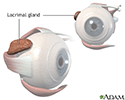Dacryoadenitis
Dacryoadenitis is inflammation of the tear-producing gland (lacrimal gland).
Acute dacryoadenitis is most commonly due to viral or bacterial infection. Common causes include mumps, Epstein-Barr virus, staphylococcus, and gonococcus.
Chronic dacryoadenitis is most often due to noninfectious inflammatory disorders. Examples include sarcoidosis, thyroid eye disease, and orbital pseudotumor.
Symptoms
Symptoms may include:
- Swelling of the outer portion of the upper eyelid, with possible redness and tenderness
- Pain in the area of swelling
- Excess tearing or discharge
- Swelling of lymph nodes in front of the ear
Exams and Tests
Dacryoadenitis can be diagnosed by an exam of the eyes and lids. Special tests, such as a CT scan may be needed to look for the cause. Sometimes a biopsy will be needed to make sure that a tumor of the lacrimal gland is not present.
Treatment
If the cause of dacryoadenitis is a viral condition such as mumps, rest and warm compresses may be enough. In other cases, the treatment depends on the disease that caused the condition.
Outlook (Prognosis)
Most people will fully recover from dacryoadenitis. For more serious causes, such as sarcoidosis, the outlook depends on the disease that caused this condition.
Possible Complications
Swelling may be severe enough to put pressure on the eye and distort vision. Some people who were first thought to have dacryoadenitis may turn out to have cancer of the lacrimal gland.
When to Contact a Medical Professional
Contact your health care provider if swelling or pain increase despite treatment.
Prevention
Mumps can be prevented by getting vaccinated. You can avoid getting infected with gonococcus, the bacteria that cause gonorrhea, by using safe sex practices. Most other causes cannot be prevented.
References
Durand ML. Periocular infections. In: Bennett JE, Dolin R, Blaser MJ, eds. Mandell, Douglas, and Bennett's Principles and Practice of Infectious Diseases. 9th ed. Philadelphia, PA: Elsevier; 2020:chap 116.
McNab AA. Orbital infection and inflammation. In: Yanoff M, Duker JS, eds. Ophthalmology. 6th ed. Philadelphia, PA: Elsevier; 2023:chap 12.14.
Review Date: 8/5/2024










